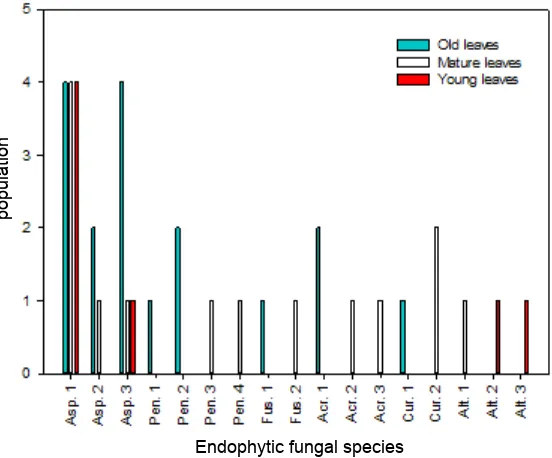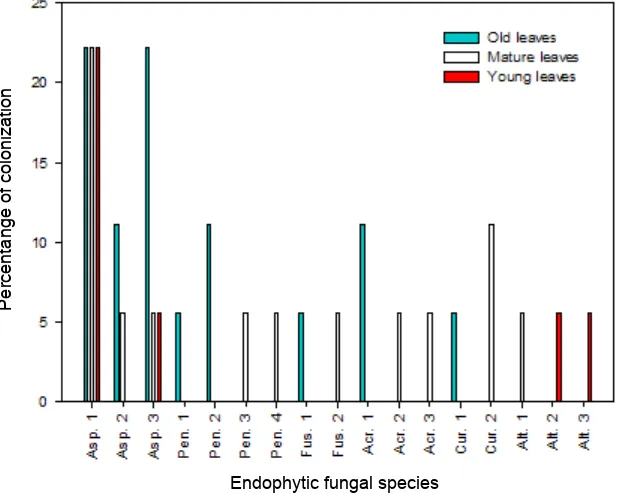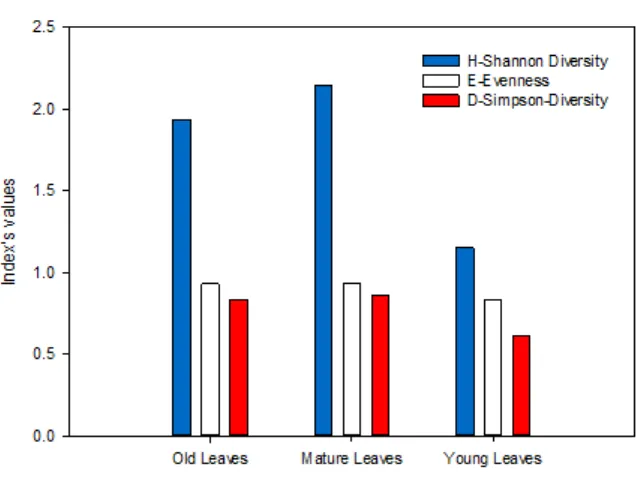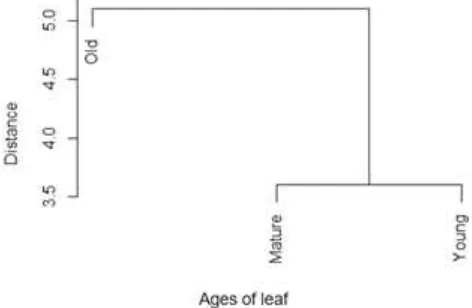INTRODUCTION
Endophytic fungi are microorganisms that are in the plant tissue during certain periods of their life cycle, without causing damage to the plants (Hilarino et al., 2011). It play an important role in balancing ecosystems and benefiting the host such as increasing plant growth (Zheng et al., 2017).
Abundance and diversity of endophytic fungi species increases with increasing leaf age (López-González et al., 2017). Hilarino et al. (2011) claimed that differences in the composition of endophytic fungi on the leaves of Bauhinia brevipes influenced by the age of the leaf. Endophytic fungi colonization is higher in the leaves of certain associated with anatomical structures and susceptibility to infection, changes in biochemical influences (Fernandes, Oki, Sanchez-Azofeifa, Faccion, & Amaro-Arruda, 2011) and leaf nutrient content such as chlorophyll.
Understand the abundance and diversity of endophytic fungi on apple leaves is the key to know in the ecology and the association between endophytic fungi and plants. The research of endophytic fungi have been many developed knowledge about influence of plant resistance to climate, pathogens and insect pests. Endophytic fungi that colonize a host plant will affect the presence of insects, especially pest insects into the host. Endophytic fungi Nigrospora oryzae and Cladosporium Arenicola isolated from plant Tinospora cordifolia able to suppress the development of the larvae of Spodoptera litura (Thakur, Singh, Kaur, & Kaur, 2014). In addition, endophytic fungi are also capable of inhibiting pathogens thus showing potential as a biocontrol agent (López-González et al., 2017). The important role can be influenced by abundance and diversity of endophytic fungi in the ecosystem as a whole.
Distribution of the Endophytic Fungi in Apple Leaves
Aminudin Afandhi*), Fery Abdul Choliq, Havinda Anggrilika W.S. and Hagus Tarno Pest and Plant Disease Department, Faculty of Agriculture, Universitas Brawijaya, Indonesia
ARTICLE INFO
Keywords: Abundance Apple leaf Diversity
Endophytic fungi Article History:
Received: August 3, 2017 Accepted: December 8, 2017
*) Corresponding author:
E-mail: aaf_fp@ub.ac.id
ABSTRACT
Apple as one of popular fruit in Indonesia, is cultivated in the highlands of Indonesia such as in Batu City. One obstacle is the cultivation of apple pests and diseases. Pests and diseases occurs after the leaves removed. Endophytic fungi of apple leaves in Brazil are Alternaria sp., Botryosphaeria sp., Cladosporium sp., Colletotrichum sp., Epicoccum sp., Fusarium sp., and Xylaria sp. (Camatti-Sartori et al., 2005). Endophytic fungi have roles to protect the plant from herbivorous insects and diseases, to support the absorption process of nutrients needed by plants for photosynthesis. Meanwhile, the results of plant photosynthesis can be used fungus for life sustainability. Related to the important roles of endophytic fungi on a host plant, this research aimed to identify fungal endophytes associated with young, mature and old leaves on apple and to evaluate the effect of leaf ages on the abundance and diversity of endophytic fungi.
MATERIALS AND METHODS
Sampling and Isolation of Endophytic Fungi Sampling was conducted on apple orchard in Bumiaji Village, Bumiaji Subdistricts, Batu City (Coordinates: S 7°51’32.4” and E 112°32’20.1”), altitude 1062 m above sea level (masl). Isolation and identification conducted in Biological Control Laboratory of Department of Pests and Plant Diseases, Faculty of Agriculture, Universitas Brawijaya. The study was conducted from May to September 2016.
For sampling purposes, nine apple trees were done diagonally that leaves samples drawn more equally. Each one tree taken 6 leaves, 2 leaves were taken from the young leaves of the sequence number 2 of shoots, 2 mature leaves were taken from the leaves of the sequence number 4 of shoots, and 2 old leaves were taken from the leaves of the sequence number 6 of shoots. There were 54 strands of total leaf samples. Parts of plants were taken to the exploration process were in a healthy condition. Leaf samples were collected in an envelope and taken to a laboratory to be isolated.
Early stages of isolation to prepared a leaves sample apple was washed with running water until clean of dirt, then dried on sterile wipes. Sterilization using method of Greenfield et al. (2015) which leaves soaked in the solution of 0.5 % NaOCl for 3 minutes, 70 % alcohol for 1 minute and rinsed with sterile distilled water for 3 times each 15 seconds and then dried using sterile wipes. Each leaf was cut 1 cm x 1 cm as much as 6 leaf pieces, so the Petri
dish contained 6 leaf pieces. Then a leaf samples were isolated in a Sabauraud Dextrose Agar Yeast media (SDAY) in 9 cm diameter Petri dishes and coded. Materials for the manufacture of media SDAY namely dextrose 10 g, peptone 2.5 g, to 20 g, yeast extract 2.5 g, chloramphenicol 0.5 g and distilled water 1 l. Last rinse of distilled water was taken 1 ml and isolated in a new SDAY media, this treatment was used as an insulating material sterility testing of microorganisms other than endophyte.
Identification of the Isolates
Identification of isolates morphological macroscopic and microscopic. Identification was done at the genus level. Observations were made every day for 7 days after the inoculation, if found new colonies that grow so do the purification of the new SDAY media (Subculture 1). Macroscopic identification was done by observing the macroscopic characteristics includes color colony, colony surface texture, diameter and colonies form. Microscopic identification was done by taking most isolates selected using a needle ose then placed on an object glass and closed with a cover glass. Observations were made under a microscope with parameters including hyphae (sectional or not and branched or not), the shape of conidiophores, conidia (shape and size) and specific characteristics to determine the type of fungus by using reference books Illustrated Genera of Imperfect Fungi.
Statistical Analysis
Abundance of Endophytic Fungi
The rate of colonization percentage of endophytes was calculated by using equation 1 (Chougule & Andoji, 2015).
Rate of colonization x100% (1)
where: NSCSF is Number of Segmented Colonized by Single Fungus; TNSO is Total Number of Segmented observed
Diversity of Endophytic Fungi
Several indices to describe alfa diversity such as Simpson Index, species diversity indices and species Evenness indices were calculated (Habib, Heshmati, & Siroosi, 2014; Shannon, 1948; Tarno, Septia, & Aini, 2016). Simpson index (D), species diversity indices (H’) and Species Evenness indices (E) were described in Equation 2, 3, and 4 respectively
TNSO NSCSF
... (2) ... (3)
Remarks: Simpson index, index of species diversity, proportion of individuals of species i in the community, number of species in the sample, and logarithm are D, H’,
Pi, S and log respectively.
... (4)
Remarks: index of species diversity, exponential logarithm, and proportion of individuals of speciesare H’,
ln and S, respectively.
Value of Shannon-Winner Indices (H’) are describes as low level of diversity (with value <1), low individual distribution of each species, middle level of diversity (1-3), middle level of individual distribution for each species, and high level of diversity (>3), high level of individual distribution for each species (Tarno, Septia, & Aini, 2016).
Based on value of Evenness index, there are three categories i.e.: low (0.00<E<0.50) described as under pressure community, medium level (0.50<E<0.75) described as unstable community, and high level (0.75<E<1.00) described as stable community. In addition, beta diversity was also calculated by using Bray-Curtis similarity index to describe similarity between three different of ages of leaf on apple based on all observed endophytic fungal species. Alfa and beta diversities were calculated by using Vegan package of R Software (R Core Team, 2013).
RESULTS AND DISCUSSION
Abundance Endophytic Fungi
Six of endophytic fungal genera were identified from old, mature, and young apple leaves i.e.: Aspergillus, Penicillium, Fusarium, Acremonium, Curvularia and Alternaria. The results showed that,
in the old apple leaves, it obtained 17 isolates that consisted of five genera, mature leaves obtained 14 isolates consisted of six genera, and young leaves 7 isolates obtained consists of two genera. Abundance of endophytic fungi on host plants affected by the isolated organ, the sampling locations and age of leaves. Abundance of endophytic fungi obtained from a sample of leaves colonized endophytic fungi, endophytic fungi colonization percentage and the percentage of total colonization of endophytic fungi.
Each leaves sample with different criteria namely the old, mature and young apple leaves colonized types of endophytic fungi were different (Fig. 1). Colonization of endophytic fungi varies according to leaf age (Sanchez-Azofeifa, Oki, Fernandes, Ball, & Gamon, 2012). Aspergillus sp. 1 and Aspergillus sp. 3 samples colonized old, mature and young apple leaves. Aspergillus sp. 2 colonized the old and mature leaves samples. Penicillium sp. 1, Penicillium sp. 2, Fusarium sp. 1, Acremonium sp. 1, and Curvularia sp. 1 colonized the old leaves sample. Penicillium sp. 3, Penicillium sp. 4, Fusarium sp. 2, Acremonium sp. 2, Acremonium sp. 3, Curvularia sp. 2, and Alternaria sp. 1 colonized the mature leaves sample. Meanwhile, Alternaria sp. 2 and Alternaria sp. 3 colonized the young leaves.
Fig. 1. Population of colonized endophytic fungi in each age of leaf; Aspergillus sp1 (Asp.1), Aspergillus sp2 (Asp.2), Aspergillus sp3 (Asp.3), Penicillium sp1 (Pen.1), Penicillium sp2 (Pen.2), Penicillium sp3 (Pen.3), Penicillium sp4 (Pen.4), Fusarium sp1 (Fus.1), Fusarium sp2 (Fus.2), Acremonium sp1 (Acr.1), Acremonium sp2 (Acr.2), Acremonium sp3 (Acr.3), Curvularia sp1 (Cur.1), Curvularia sp2 (Cur.2), Alternaria sp1 (Alt.1), Alternaria sp2 (Alt.2), and Alternaria sp3 (Alt.3).
Fig. 2. Boxplot of population of each endophytic fungus species on all ages of leaves; Aspergillus sp1 (Asp..1), Aspergillus sp2 (Asp.2), Aspergillus sp3 (Asp.3), Penicillium sp1 (Pen.1), Penicillium sp2 (Pen.2), Penicillium sp3 (Pen.3), Penicillium sp4 (Pen.4), Fusarium sp1 (Fus.1), Fusarium sp2 (Fus.2), Acremonium sp1 (Acr.1), Acremonium sp2 (Acr.2), Acremonium sp3 (Acr.3), Curvularia sp1 (Cur.1), Curvularia sp2 (Cur.2), Alternaria sp1 (Alt.1), Alternaria sp2 (Alt.2), and Alternaria sp3 (Alt.3).
Species
population
Endophytic fungal species
Percentage colonization of endophytic fungi in old, mature and young apple leaves can be seen on Fig. 3. In the old leaves obtained five genera are Aspergillus, Penicillium, Fusarium, Acremonium and Curvularia. In the mature leaves obtain six genera are Aspergillus, Penicillium, Fusarium, Acremonium, Curvularia and Alternaria. While the young leaves obtained two genera are Aspergillus, and Alternaria. Colonization of endophytic fungi genus Aspergillus in old, mature and young apple leaves showed the highest percentage (Fig. 4). Colonization of endophytic fungi on old, mature and young apple leaves showed their dominance of the genus Aspergillus. In this study, samples of old, mature and young apple leaf isolated endophytic fungi have different total colonization. The results showed that the mature apple leaves have the highest percentage of total colonization of 66.67 %, followed by 50 % of the old leaves and young leaves 38.89 %. It shows that the mature leaves were higher compared to the old and young apple leaves based on colonization or abundance. The colonization is influenced by the age of leaves.
Abundance and diversity of endophytic fungal species increases with increasing leaf age (López-González et al., 2017).
Diversity of Endophytic Fungi
Diversity of endophytic fungal species was analyzed by using Shannon-Winner (H’) and Simpson Diversity Indexes (D). In addition, Evenness index (E) was also used to analyze diversity. 14, 17 and 7 isolates of endophytic fungi collected from mature, old and young leaves resulted six, five and two endophytic fungal genera, respectively.
Based on H’, mature and young leaves resulted the highest (more than 2.0) and lowest values (more than 1.0) (Fig. 5). Mature, old and young leaves produced index’s value between 1 and 3, and it’s mean that diversities on each age of leaf on the middle level of diversity status (middle level of individual distribution for each species) (Tarno, Septia, & Aini, 2016). Evenness index showed that all three ages of leaf produced the high value (more than 0.75) or stable communities. H’, D and E indexes showed that all ages of leave on the middle level diversity and stable communities.
Endophytic fungal species
Percentange of colonization
Abundance and diversity of endophytic fungi from mature leaves higher than the old and young leaves of apple allegedly relates to compounds of photosynthesis that supports the growth and development of endophytic fungi. Getting old apple leaves are green, green leaves tend to lack the chlorophyll higher than young leaves. The higher the content of chlorophyll in the leaves, the higher the rate of photosynthesis. Results of photosynthesis used for plant growth and development but it is
also used endophytic fungi to survive in the plant tissue.Thus, the leaves have a higher chlorophyll content is characterized by dark green color, the number and types of endophytic fungi on the leaves higher. Hilarino et al. (2011) in his study claimed that differences in the composition of endophytic fungi on the leaves of Bauhinia brevipes influenced by the age of the leaf. The leaves are aging tend to receive more nutrients, so the old leaves to get more chlorophyll, leaf color more green old age. Fig. 4. Total percentage of colonization of endophytic fungi
Fernandes, Oki, Sanchez-Azofeifa, Faccion, & Amaro-Arruda (2011) adds that the old leaves more favorable to the colonization of the fungus, leaf biochemical changes influence affecting the distribution of endophytic colonization. Endophytic fungi are mutualistic symbiosis with the host plant. Endophytic fungi help the absorption of nutrients needed by plants for photosynthesis and photosynthesis results can be used fungi in order to survive. Abundance and diversity of endophytic fungi in old leaves lower than mature leaves, old leaves suspected decreased chlorophyll content so that colonization of endophytic fungi that are in the old leaves is reduced. Decreased levels of chlorophyll in the leaves affects the rate of photosynthesis, photosynthetic rate lower if the compounds that plants need and endophytic fungi on the wane. Plant and fungal endophyte can’t absorb the nutrients optimally. Endophytic fungi survive in host plants are influenced by environmental factors such as temperature and humidity, chemicals and leaf anatomic structures. Thus, affects the abundance and diversity of endophytic fungi (Sanchez-Azofeifa, Oki, Fernandes, Ball, & Gamon, 2012). Changes in endophytic fungi communities are related to leaf age (Fernandes, Oki, Sanchez-Azofeifa, Faccion, & Amaro-Arruda, 2011, Hilarino et al., 2011) and even to plant tissue types (Sanchez-Azofeifa, Oki, Fernandes, Ball, & Gamon, 2012). Many biotic and abiotic factors are involved in colonization, including chemical and plant structure (Sanchez-Azofeifa, Oki, Fernandes, Ball, & Gamon, 2012), and environmental conditions where endophytic fungi are present (Fernandes, Oki, Sanchez-Azofeifa, Faccion, & Amaro-Arruda, 2011).
Endophytic fungi in addition to helping the plant in the absorption of nutrients, it also protects the plants against pathogens and insect herbivores. Plant defense system is stronger when various types of endophytic fungi are mutualistic symbiosis with plants. Many reports of endophytic fungi are mutualistic to the plant than endophytes are pathogen. Host plant and endophytic fungi mutualism association by way of endophytic fungi obtain nutrients and survive in plants tissue, while the host plants get nutrients in the defense system, growth, and reproduction. Thus, leaves
Endophytic fungi of the genus Aspergillus predominantly found in old, mature and young apple leaves. Ariyono, Djauhari, & Sulistyowati (2014) states that the kale leaves land in organic fields are dominated by the genus Aspergillus. Aspergillus sp. is a cosmopolitan fungi has a wide host range, being in nature as a saprophyte fungi, parasites and spores can easily spread through the air. Fungus Penicillium sp., Fusarium sp., Acremonium sp. and Curvularia sp., found on old leaves and mature, but not found in young leaves apple. Endophytic fungi Fusarium sp., Penicillium sp., and Curvularia sp. endophyte found in the leaves of potato (Tirtana, Sulistyowati, & Cholil, 2013). While, according to Hilarino et al. (2011), states that the fungus endophyte Acremonium sp. obtained from the leaves Bauhinia brevipes. Fungus Alternaria sp., found in the mature leaves and young but not found on old leaves apple. Camatti-Sartori et al. (2005) states that the endophytic fungus Alternaria sp. reported as an endophyte in apple leaves in Brazil. Endophytic fungi obtained from old, mature and young apple leaves have different types as it relates to micro ecological and physiological condition of each leaf that supports the growth of endophytic fungi, thus affecting the number and types of endophytic fungi were found. Endophytic fungi isolated from old, mature and young apple leaves has a type and the number of different isolates, allegedly influenced by the survivability of endophytic fungi against micro ecological and physiological condition of each leaf.
Endophytic fungi survive in host plants are influenced by environmental factors such as temperature and humidity, chemicals and leaf anatomic structures. Thus, it affects the abundance and diversity of endophytic fungi (Sanchez-Azofeifa,
Oki, Fernandes, Ball, & Gamon, 2012). The abundance and diversity of endophytic fungi in host plants illustrates the components of biodiversity. In addition, as bio indicators of the health of plants. Each host plants have diverse environmental conditions for growing a fungal endophyte. In almost all tissues of healthy plants are endophytic microorganisms that colonize. Many studies suggest benefits of colonization of endophytic fungi in plant tissues such as strengthening plant resistance to insect herbivores, pathogens, defense against extreme weather, produces growth regulators, antibiotics, anticancer and antioxidant. However, so far the interaction of each type of endophytic fungi that colonize a host plant has not been clearly reported. Several types of endophytic fungi that colonize a host plant allegedly symbiotic mutualism, so as to protect crops from adverse environmental effects.
Bray–Curtis similarity was adopted in this analysis to evaluate the similarity between all ages of leaf. It was widely employed in multivariate analysis of assemblage data, for sound biological reasons (Clarke, Somerfield, & Chapman, 2006). Based on Fig. 6, there are two clusters of diversity between all three ages of leaf. Mature and young leaves are on the same cluster, and it showed different from old leaves. Composition of endophyte fungal species between mature and young leaves were different to the old one.
CONCLUSION
and young leaves 7 isolates obtained consists of 2 genera. Aspergillus sp. dominated on all ages of apple leaf. Mature and young leaves were different from old one based Bray-Curtis similarity.
REFERENCES
Ariyono, R. Q., Djauhari, S., & Sulistyowati, L. (2014). Keanekaragaman jamur endofit daun kangkung darat (Ipomoea reptans Poir.) pada lahan pertanian organik dan konvensional [The diversity of the endophytic fungi of land kangkong (Ipomoea reptans Poir.) on organic and conventional farmland]. Jurnal HPT, 2(1), 19-28. Retrieved from http://jurnalhpt.ub.ac.id/ index.php/jhpt/article/view/63
Camatti-Sartori, V., Da Silva-Ribeiro, R. T., Valdebenito-Sanhueza, R. M., Pagnocca, F. C., Echeverrigaray, S., & Azevedo, J. L. (2005). Endophytic yeasts and filamentous fungi associated with southern Brazilian apple (Malus domestica) orchards subjected to conventional, integrated or organic cultivation. Journal of
Basic Microbiology, 45(5), 397–402. http://doi.
org/10.1002/jobm.200410547
Chougule, P. M., & Andoji, Y. S. (2015). Isolation and frequency distribution of Endophytic fungi inhabiting Justicia adhatoda L. Research Journal of Life Sciences, Bioinformatics,
Pharmaceutical and Chemical Sciences, 1(4),
215-218. Retrieved from http://rjlbpcs.com/ wp-content/uploads/2015/Nov-Dec/4-Isolation- and-frequency-distribution-of-Endophytic-fungi-inhabiting.pdf
Clarke, K. R., Somerfield, P. J., & Chapman, M. G. (2006). On resemblance measures for ecological studies, including taxonomic dissimilarities and a zero-adjusted Bray-Curtis coefficient for denuded assemblages. Journal of Experimental
Marine Biology and Ecology, 330(1), 55–80.
https://doi.org/10.1016/j.jembe.2005.12.017
Fernandes, G. W., Oki, Y., Sanchez-Azofeifa, A., Faccion, G., & Amaro-Arruda, H. C. (2011). Hail impact on leaves and endophytes of the endemic threatened Coccoloba cereifera (Polygonaceae).
Plant Ecology, 212(10), 1687–1697. http://doi.
org/10.1007/s11258-011-9941-z
Greenfield, M., Pareja, R., Ortiz, V., Gómez-Jiménez, M. I., Vega, F. E., & Parsa, S. (2015). A novel method to scale up fungal endophyte isolations. Biocontrol
Science and Technology, 25(10), 1208–1212.
http://doi.org/10.1080/09583157.2015.1033382
Habib, R. K., Heshmati, G., & Siroosi, H. (2014). Comparison of ecological patches’ potentials and functions in rangeland ecosystems (case study: Qahavand Rangelands, Hamedan Province, Iran). Journal of Rangeland Science, 4(3),
234-245. Retrieved from http://www.rangeland.ir/ article_513017.html
Hilarino, M. P. A., Silveira, F. A. de O. e, Oki, Y., Rodrigues, L., Santos, J. C., Corrêa Junior, A., … Rosa, C. A. (2011). Distribution of the endophytic fungi community in leaves of Bauhinia brevipes (Fabaceae). Acta Botanica Brasilica, 25(4), 815– 821. http://doi.org/10.1590/S0102-33062011000 400008
Irmawan, D. E. (2007). Kelimpahan dan keragaman
cendawan endofit pada beberapa varietas padi
di Kuningan, Tasikmalaya dan Subang, Jawa
Barat [Abundance and diversity of endophytic
fungi on several rice varieties in Kuningan, Tasikmalaya and Subang, West Java]. Retrieved from http://repository.ipb.ac.id/jspui/ bitstream/123456789/44597/1/A07dei.pdf
López-González, R. C., Gómez-Cornelio, S., De la Rosa-García, S. C., Garrido, E., Oropeza-Mariano, O., Heil, M., & Partida-Martínez, L. P. (2017). The age of lima bean leaves influences the richness and diversity of the endophytic fungal community, but not the antagonistic effect of endophytes against Colletotrichum lindemuthianum. Fungal Ecology, 26, 1-10. http://doi.org/10.1016/j.funeco.2016.11 .004
Mei, C., & Flinn, B. S. (2010). The use of beneficial microbial endophytes for plant biomass and stress tolerance improvement. Recent Patents
on Biotechnology, 4(1), 81–95. http://doi.
org/10.2174/187220810790069523
Odum, E. P. (1993). Dasar-dasar ekologi [Fundamentals
of Ecology]. (T. Samingan, Trans.). Yogyakarta: Gadjah Mada University Press. (Orginal work published 1953)
R Core Team. (2013). R: A language and environment for
statistical computing. Vienna, AT: R Foundation
for Statistical Computing.
Sanchez-Azofeifa, A., Oki, Y., Fernandes, G. W., Ball, R. A., & Gamon, J. (2012). Relationships between endophyte diversity and leaf optical properties.
Trees - Structure and Function, 26(2), 291–299.
Shannon, C. E. (1948). A mathematical theory of communication. The Bell System Technical
Journal, 27, 379–423. http://doi.org/10.1145/5840
91.584093
Sieber, T. N. (2007). Endophytic fungi in forest trees: Are they mutualists? Fungal Biology Reviews. http:// doi.org/10.1016/j.fbr.2007.05.004
Tarno, H., Septia, E. D., & Aini, L. Q. (2016). Microbial community associated with ambrosia beetle, Euplatypus parallelus on sonokembang, Pterocarpus indicus in Malang. AGRIVITA
Journal of Agricultural Science, 38(3), 312–320.
http://doi.org/10.17503/agrivita.v38i3.628
Thakur, A., Singh, V., Kaur, A., & Kaur, S. (2014). Suppression of cellular immune response in Spodoptera litura (Lepidoptera: Noctuidae) larvae by endophytic fungi Nigrospora oryzae and Cladosporium uredinicola. Annals of the
Entomological Society of America, 107(3), 674–
679. http://doi.org/10.1603/AN13164
Tirtana, Z. Y. G., Sulistyowati, L., & Cholil, A. (2013). Eksplorasi jamur endofit pada tanaman kentang (Solanum tuberosum L.) serta potensi antagonismenya terhadap Phytophthora infestans
(Mont.) de Barry penyebab penyakit hawar daun secara in vitro [Exploration of endophytic fungi in potato plants (Solanum tuberosum L.) and potential antagonism against Phytophthora infestans (Mont.) de Barry causes leaf blight disease in vitro]. Jurnal HPT, 1(3), 91-101. Retrieved from
http://download.portalgaruda.org/article.php? rticle=190870&val=6471&title=EKSPLORASI%20 J A M U R % 2 0 E N D O F I T % 2 0 PA D A % 2 0 TANAMAN%20KENTANG%20(Solanum%20 tuberosum%20L)%20SERTA%20POTENSI%20 ANTAGONISMENYA%20TERHADAP%20 Phytophthora%20infestans%20(Mont.)%20 de%20Barry%20PENYEBAB%20PENYAKIT%20 HAWAR%20DAUN%20SECARA%20IN%20 VITRO
Zakaria, L., Yaakop, A. S., Salleh, B., Zakaria, M., & Pinang, P. (2010). Short communication endophytic fungi from paddy. Tropical Life
Sciences Research, 21(1), 101–107.
Zheng, Y. K., Miao, C. P., Chen, H. H., Huang, F. F., Xia, Y. M., Chen, Y. W., & Zhao, L. X. (2017). Endophytic fungi harbored in Panax notoginseng: Diversity and potential as biological control agents against host plant pathogens of root-rot disease. Journal
of Ginseng Research, 41(3), 353–360. http://doi.



